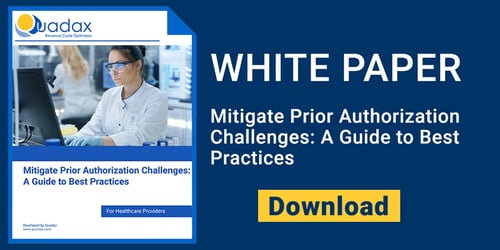What comes to mind when you hear “Artificial Intelligence” (AI)? From product pitches to the nightly news, the term AI is showing up everywhere. But just what are we talking about when we talk about AI? Driverless cars and robotically-assisted surgery? Postal-sorting machines and facial recognition at Passport Control? Siri and Alexa? Smart forms in EHRs and product recommendations on Amazon? Since this field of research gained popularity in the 1950s, computers’ capabilities have advanced exponentially. As our understanding of human intelligence has also improved, so too has our concept of what programs designed to replace human intelligence should be capable of doing.
Early initiatives to produce AI protocols consisted of distilling human knowledge into programming logic—lines of code to account for every variation of a particular scenario. Chess games could be won by a computer programmed with millions of potential moves, able to go through its library in mere seconds and calculate possible moves and outcomes based on known values. Algorithms were to be credited with success more so than what we today call machine learning. However, in the years between IBM Deep Blue’s defeat of chess master Kasparov in 1997 and Watson’s 2011 Jeopardy win, ground-breaking advances included natural language processing, improved information retrieval, automated reasoning and evolved machine learning capabilities.
Computers are not yet able to replicate human abstract thinking, high-level reasoning, or very complex problem-solving to fulfill the aspiration of “human-imitative AI.” However, advances in machine learning are happening rapidly. According to venture capital firm BGV, “Healthcare creates self-running growth by leveraging technologies that enable machines to sense, comprehend, act, and learn to perform administrative and clinical healthcare functions to augment human activity” and “The market is forecasted to be worth $6.6B by 2021, with a 40% compound annual growth rate.”[i]
Anticipated clinical applications of AI include reading and interpreting diagnostic imaging, producing medical diagnoses, predicting the most effective (and least risky) prescription drugs, and facilitating more productive patient engagement. The journal Nature suggests AI can already diagnose skin cancer more accurately than a board-certified dermatologist.
The non-clinical applications of AI in healthcare are equally promising. AI is expected to transform the data-rich revenue cycle environment into a streamlined, proactive (rather than reactive), healthy financial enterprise characterized by speed and accuracy. The power of sophisticated algorithms to convert data analysis to insights and then to action will eliminate human error, preempt obstacles to reimbursement, and feed strategic discussions.
At this point in time, though, many of the hopes for AI still outstrip its reality.
While work continues to develop capabilities and perfect responses, other issues persist. The AMA Journal of Ethics warns “ethical challenges must be identified and mitigated since AI technology has tremendous capability to threaten patient preference, safety, and privacy.”[ii] Some have raised concerns pertaining to the values programmed into the decision-making algorithms—whether biases inherent to the humans developing the technology are lurking in the AI. How legal liability will be handled in cases of unintended consequences or errors in judgment. And more basically, whether or not an AI system can be trusted.
Undoubtedly, technology will advance to an integrative intelligence model combining different competencies (machine learning, natural language processing, vision, predictive modeling, and robotics) to produce human-imitative AI, and the accompanying ethical and legal dilemmas will be explored, debated, and resolved.
In the meantime, revenue cycle professionals will realize significant benefits from technologies upstream of human-imitative AI. The starting place for the progression of artificial intelligence development, as we have seen, was a rules-based, if/then schema we may now think of as Intelligent Automation (IA). IA is now offering cost savings and operational advances to healthcare organizations.
Intelligent automation features rules-based routines to enable an application to handle repetitive tasks, particularly those with high-volume. Any time there is a clear relationship between the circumstances necessitating intervention and the prescribed solution, it can be—and should be—automated. In the revenue cycle, such tasks are abundant. Prime candidates for automation include eligibility processing, assigning workflow statuses, correction of known errors, cross-walking new provider credentials, claim status checking, remittance splitting, payment posting, and other revenue cycle tasks which are not complicated, but typically require mind-numbingly repetitive manual intervention.
IA delivers on the promises often attributed to AI for streamlined work, greater productivity, and lower costs. For example:
- Streamline your claims management by relying on IA for data conversions, workflow management, auto-correction of known issues, and segregating those claims requiring extra attention prior to submission.
- In your denials management and your collections efforts, use IA to move toward an exception-based work environment for greater productivity and a reduction in the volume of work you must outsource.
- Automating certain revenue cycle tasks gives you extra bang for the buck – consider revenue leakage uncovered by the intelligent analytics of a contract management system. Using human capital, you can’t necessarily afford to pursue large quantities of low-dollar shortages. With automated efforts, you can. You win by not only repurposing staff and pursuing the high-dollar shortages staff already worked on, but also by recovering shortages previously written off.
Another tremendous advantage of the implementation of IA is the freedom to move human capital away from menial tasks into more meaningful work. The workforce is thereby enhanced, improving both staff retention and expanding reach to improve operations.
When Adena Health System implemented RemitMax to convert paper-based payment documents to machine-postable ANSI 835s, jobs within the business office, particularly for cash posters, were radically revised. Angela Lowery said, “It’s changed our mindset from ‘gotta key, gotta key, gotta key’ to an analytical approach of identifying payment problems and working toward solving them. You’re thinking, you’re reviewing, you’re analyzing, you’re contacting other teams and working with them. It’s truly been transformational.” (To learn more about the benefits Adena Health enjoys with RemitMax, read the case study.)
Begin the Journey
The science and technology of artificial intelligence will inexorably become more complex with greater precision, particularly for clinical applications. As AI continues to mature, don’t miss the opportunities afforded by IA.
Quadax solutions reduce complexity in the revenue cycle with intelligent automation in the areas of patient access, claims management, reimbursement management, denials and appeals management, and business intelligence. Using Quadax tools, our clients enjoy more control, better data, and better cash flow. Let’s talk about the difference Quadax IA can make in your revenue cycle!
[i] https://benhamouglobalventures.com/2018/08/02/digital-transformation-of-healthcare-state-of-the-union/
[ii] AMA J Ethics. 2019;21(2):E121-124.




 Ken Magness is a focused healthcare professional with more than a decade of experience in helping clients understand the true value of automation in the revenue cycle management process. As the Strategic Initiatives Leader at Quadax, Ken and his team are passionate about connecting with healthcare providers to help them create and leverage the appropriate technology solutions to optimize the revenue cycle process and improve the experience of their patients and staff.
Ken Magness is a focused healthcare professional with more than a decade of experience in helping clients understand the true value of automation in the revenue cycle management process. As the Strategic Initiatives Leader at Quadax, Ken and his team are passionate about connecting with healthcare providers to help them create and leverage the appropriate technology solutions to optimize the revenue cycle process and improve the experience of their patients and staff.


 Ken Magness is a focused healthcare professional with more than a decade of experience in helping clients understand the true value of automation in the revenue cycle management process. As the Strategic Initiatives Leader at Quadax, Ken and his team are passionate about connecting with healthcare providers to help them create and leverage the appropriate technology solutions to optimize the revenue cycle process and improve the experience of their patients and staff.
Ken Magness is a focused healthcare professional with more than a decade of experience in helping clients understand the true value of automation in the revenue cycle management process. As the Strategic Initiatives Leader at Quadax, Ken and his team are passionate about connecting with healthcare providers to help them create and leverage the appropriate technology solutions to optimize the revenue cycle process and improve the experience of their patients and staff.



